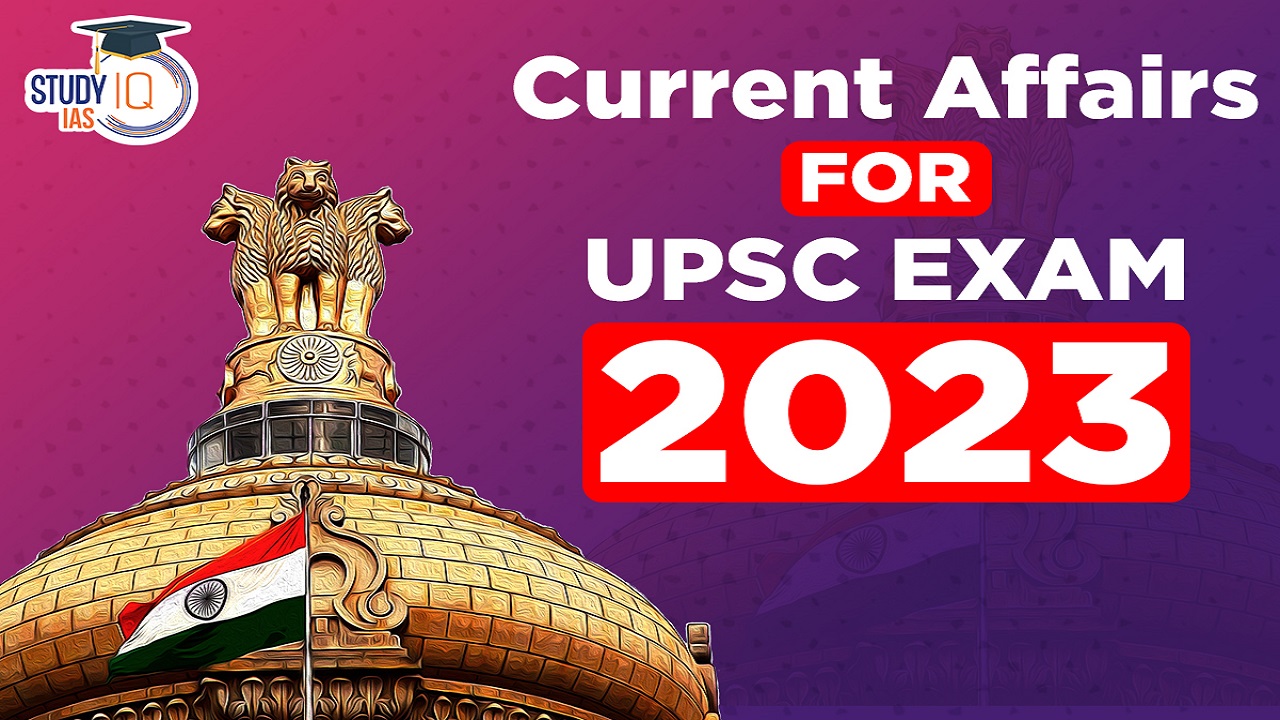Current Affairs 14th September 2023 for UPSC Prelims Exam
Overnight Index Swap
Context: Indian overnight index swap (OIS) rates rose to their highest levels in 10 months on Monday due to offshore paying and triggering of stop losses.
More on the news
- The one-year swap rate hit 7.10 per cent, the highest level since March, while the five-year swap rate rose to 6.85 per cent, a level last seen in November 2022.
What Is an Overnight Index Swap (OIS)?
- An Overnight Index Swap (OIS) is a derivative contract in which two parties agree to exchange, or ‘swap’, interest rates over a specified period.
- Derivative refers to a type of financial contract whose value is dependent on an underlying asset, group of assets, or benchmark.
- Common derivatives include futures contracts, forwards, options, and swaps.
- One party will pay a fixed interest rate and receive a floating interest rate.
- Floating rate is usually overnight interbank rate {reference rate for Indian OIS contracts is Mumbai Interbank Outright Rate (MIBOR)}.
- The ‘overnight’ refers to the continual resetting of the rate based on the index’s daily fluctuations.
- In financial transactions, OIS is primarily used to hedge interest rate risk.
- Banks and other financial institutions utilize OIS to lock in a fixed rate, protecting against potential hikes in the overnight rate.
- Additionally, it serves as a benchmark for pricing other financial instruments.
- Significance of a rise in the OIS rates:
- An increase in the OIS rate typically means that borrowing costs for financial institutions and other market participants will rise.
- An increase in the OIS rate may be seen as an indicator of tightening liquidity or a more restrictive monetary policy stance in the broader financial markets.
About MIBOR
- The Mumbai InterBank Overnight Rate, or MIBOR, is the overnight lending offered rate for Indian commercial banks.
- MIBOR is calculated based on input from a panel of 30 banks and primary dealers.
- MIBOR was first established in 1998 and modeled after the more famous London InterBank Overnight Rate (LIBOR).
About LIBOR
- The London Interbank Offered Rate (LIBOR) is a benchmark interest rate at which major global banks lend to one another in the international interbank market for short-term loans.
- LIBOR is administered by the Intercontinental Exchange, which asks major global banks how much they would charge other banks for short-term loans.
- In the United States, LIBOR was replaced by the Secured Overnight Financing Rate (SOFR) in June 2023.
- SOFR is published by the Federal Reserve Bank of New York and is based on actual transactions in the U.S.
- In India, the RBI advised banks to stop entering LIBOR-linked contracts latest by December 31, 2021.
Current Affairs 14th September 2023 for UPSC Prelims Exam
Gresham’s Law
Context: Gresham’s law came into play most recently during the economic crisis in Sri Lanka last year, during which the dollar was driven out in Sri Lanka.
Understanding Gresham’s law
- Gresham’s law refers to the dictum that “bad money drives out good.”
- It is named after English financier Thomas Gresham who advised the English monarchy on financial matters.
- It comes into play when the exchange rate between two moneys or currencies is fixed by the government at a certain ratio that is different from the market exchange rate.
- In this situation, the undervalued currency, which is priced lower than the market rate, tends to disappear from circulation. Meanwhile, the overvalued currency remains in circulation but struggles to find buyers.
- It applies not just to paper currencies but also to commodity currencies and other goods.
The Case of Sri Lanka
- Gresham’s law became evident in Sri Lanka’s recent economic crisis when the country’s central bank fixed the exchange rate between the Sri Lankan rupee and the U.S. dollar.
- The central bank decided that the price of the U.S. dollar should not exceed 200 Sri Lankan rupees per dollar, despite black market rates suggesting a much higher value for the dollar.
- Essentially, a cap was placed on how much people could pay for a dollar, resulting in an overvalued Sri Lankan rupee and an undervalued U.S. dollar compared to the market rate.
- This led to a decrease in the availability of dollars in the official foreign exchange market and the gradual disappearance of the U.S. dollar from formal channels.
- People seeking U.S. dollars to buy foreign goods had to turn to the black market, where they had to pay significantly more than 200 Sri Lankan rupees for each U.S. dollar.
Thiers’ law
- Gresham’s law holds true only when the exchange rate between currencies is fixed under law.
- In the absence of any government law, it is good money that eventually drives bad money out of the market and not the other way round.
- This phenomenon wherein “good money drives out bad” is called Thiers’ law (named after French politician Adolphe Thiers) and it is seen as a complement to Gresham’s law.
Right to Privacy
Context: It has been six years since the Supreme Court held that right to privacy as a fundamental right in consonance with Article 21 on ‘Protection of Life and Personal Liberty’.
About Right to Privacy
- A definite legal definition of privacy‟ is not available yet some legal experts tend to define privacy as a human right enjoyed by every human being by virtue of his or her existence.
- Article 12 of the Universal Declaration of Human Rights, 1948 and Article 17 of the International Covenant on Civil and Political Rights (ICCPR), 1966, legally protect persons against “arbitrary interference” with one’s privacy, family, home, correspondence, honour and reputation.
Right to Privacy in India
- The Supreme Court described privacy and its importance in the landmark decision of K.S. Puttaswamy v. Union of India in 2017 that –
- Right to Privacy is a fundamental and inalienable right and attaches to the person covering all information about that person and the choices that he/ she makes.
- The right to privacy is protected as an intrinsic part of the right to life and personal liberty under Article 21 and as a part of the freedoms guaranteed by Part III of the Constitution.
- Restrictions (as stated in the Judgement): The right may be restricted only by state action that passes each of the three tests:
- First, such state action must have a legislative mandate,
- Second, it must be pursuing a legitimate state purpose, and
- Third, it must be proportionate i.e., such state action- both in its nature and extent, must be necessary in a democratic society and the action ought to be the least intrusive of the available alternatives to accomplish the ends.
- Existing Law on Privacy: In the absence of a specific law on privacy, this right is legally viewed under the Information Technology Act, 2000.
- The IT Act provides for safeguard against certain breaches in relation to data from computer systems.
- It contains provisions to prevent the unauthorized use of computers, computer systems and data stored therein.
e Courts Project
Context: The Union Cabinet recently approved the third phase of the e Courts project with a financial outlay of ₹7,210 crore to upgrade digital infrastructure of the lower judiciary.
About eCourts Project
- Definition: The e-Courts project that began in 2007 is a centrally sponsored scheme that is part of the National e-Governance Plan.
- Implementation: The Supreme Court is responsible for the policy planning, strategic direction and implementation while the Department of Justice (DoJ) provides the funding.
- Aim: The objective of the eCourts project is to provide designated services to litigants, lawyers and the judiciary by universal computerisation of district and subordinate courts in the country and enhancement of ICT enablement of the justice system.

- Features:
- To provide efficient & time-bound citizen centric services delivery as detailed in eCourt Project Litigant’s Charter.
- To develop, install & implement decision support systems in courts.
- To automate the processes to provide transparency in accessibility of information to its stakeholders.
- To enhance judicial productivity, both qualitatively & quantitatively, to make the justice delivery system affordable, accessible, cost effective, predictable, reliable and transparent.
- Phases:
- Phase I: In Phase-I of the eCourts Project beginning from 2007, many Court Complexes, Computer Server Rooms and Judicial Service Centres were readied for computerization of the District Courts.
- Phase II: The Phase II of the project saw a major technological upgrade in courts during the Covid crisis. The National Judicial Data Grid was part of the Phase II.
- Phase III: It is to be implemented over four years beginning from 2023. The main objective of this phase is to create a unified technology platform for the judiciary.
Major Initiatives under the Project:
- National Judicial Data Grid: NJDG (District and Taluka Courts of India) contains data of 13.23 Cr cases (pending and disposed) ensuring statistical inputs to higher authorities for making policy decisions to reduce delay and arrears.
- Case Information System (CIS) has automated processes like filing, scrutiny, registration, listing, court proceedings, disposal and notice generation.
- ePayment service: It streamlined payment of court fees, fine, penalty and judicial deposits.
- ePayment portal is integrated with state specific treasury portals like GRAS, eGRAS, JeGRAS, Himkosh, Rajkosh, SBI ePay etc.
- National Service and Tracking of Electronic Process (NSTEP): It provides electronic mechanism to bailiff by providing PDAs for speedy, transparent and timely delivery of process.
- Virtual Courts: They reduce footfalls in the courts by eliminating the physical presence of violator or advocate in the court thereby saving the precious judicial time.
- A virtual court can be managed by a judge whose jurisdiction can be extended to the entire state and working hours may be 24X7.
- eChallans: eChallans submitted in the court are automatically filed to the virtual court for adjudication.
- eFiling provides a platform to advocates and litigants to file their cases online before High Courts and District Courts.
- Use of Open-Source Technology: The entire project is built on the foundation of open source technology. Free and Open-Source Software (FOSS) without any licensing/ subscription charges, has been adopted for deploying ICT solutions at courts.
- e-Filing: e-Filing application enables electronic filing of legal papers.
- ePay: ePay is a way of paying for court through an electronic medium, without the use of cheque or cash.


 Daily Quiz 16 July 2025
Daily Quiz 16 July 2025
 US Approach to the Trade Deal with India...
US Approach to the Trade Deal with India...





















